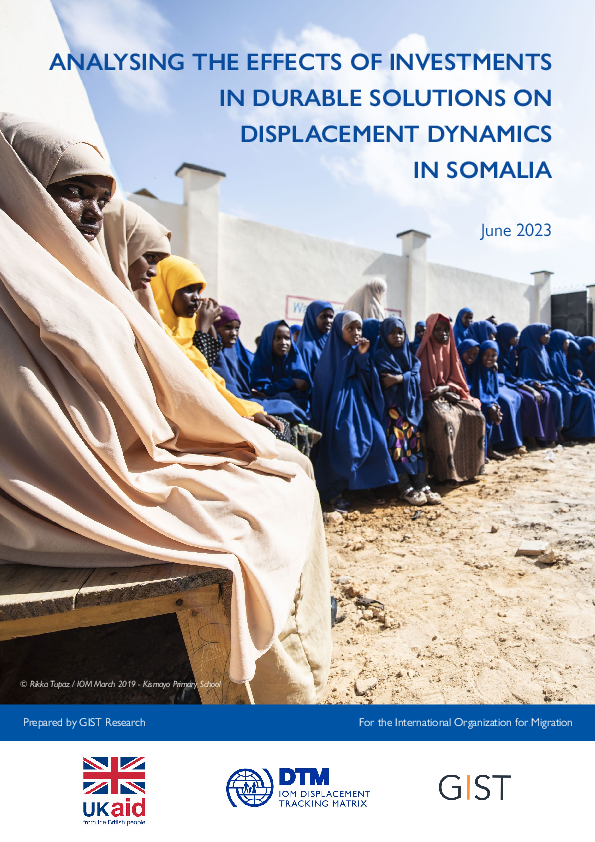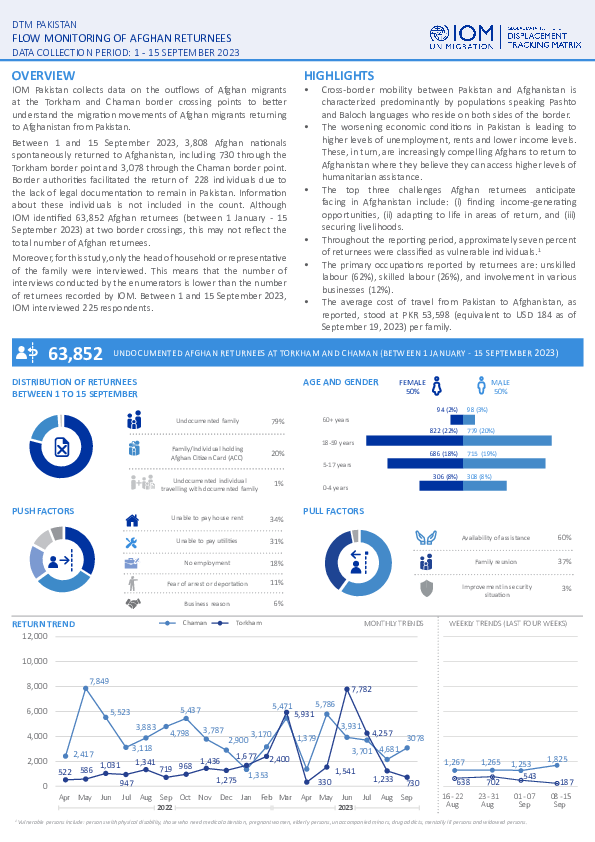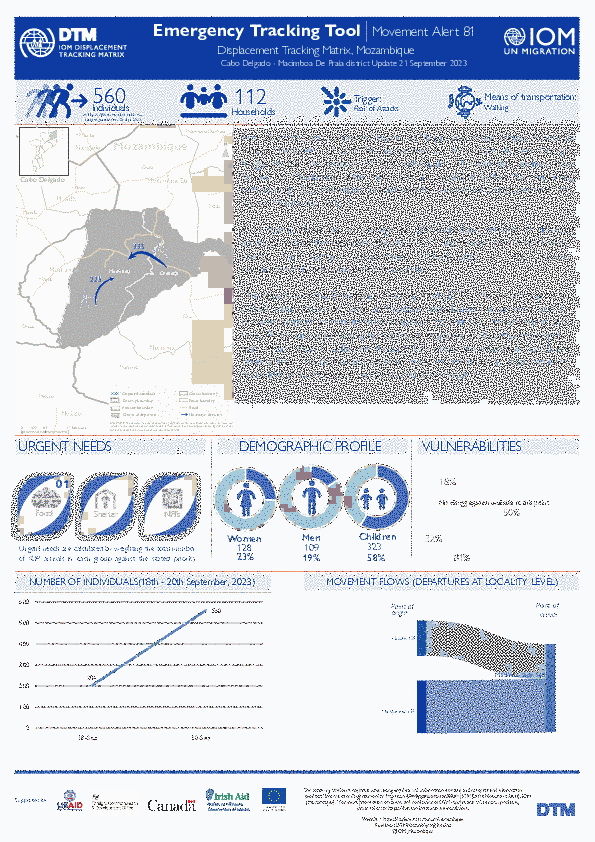-
Countries
-
Data and Analysis
-
Special Focus
-
Crisis Responses
Contact
DTM Yemen, iomyemendtm@iom.int
Location
Yemen
Activity
- Mobility Tracking
Period Covered
Sep 17 2023 -Sep 23 2023
From 1 January to 23 September 2023, IOM Yemen DTM tracked 4,478 households (HH) (26,868 Individuals) who experienced displacement at least once.
Between 17 and 23 September 2023, IOM Yemen DTM tracked 111 households (666 individuals) displaced at least once. The majority of people moved into/within the following governorates and districts:
- Ma’rib (90 HHs) – Harib (80 HHs), Ma’rib City (10 HHs) districts. Most displacements in the governorate were internal.
- Al Hodeidah (16 HHs) – Hays (13 HHs), Al Khukhah (3 HHs) districts. All displacements in the governorate were internal.
- Ta’iz (4 HHs) – Al Maafer (2 HHs), Salah (2 HHs) districts. Most displacements in the governorate originated from Ta’iz and Al Hodeidah.
- Ma’rib (80 HHs) – Harib (80 HHs) district.
- Al Hodeidah (21 HHs) – Al Jarrahi (8 HHs), Hays (5 HHs), Al Hawak (4 HHs) districts.
- Ta’iz (3 HHs) – Sharab As Salam (2 HHs), At Ta’iziyah (1 HHs) districts.
Population Groups
Survey Methodology
Unit of Analysis Or Observation
Type of Survey or Assessment
Keywords
Geographical Scope
Administrative boundaries with available data
The current dataset covers the following administrative boundaries

Contact
DTM Yemen, iomyemendtm@iom.int
Language
English
Location
Yemen
Period Covered
Sep 17 2023
Sep 23 2023
Activity
- Rapid Emergency Registration
- Mobility Tracking
IOM Yemen DTM’s Rapid Displacement Tracking (RDT) tool collects data on estimated numbers of households forced to flee on a daily basis from their locations of origin or displacement, allowing for regular reporting of new displacements in terms of estimated numbers, geography, and needs. It also tracks returnees who returned to their location of origin.
From 1 January to 23 September 2023, IOM Yemen DTM tracked 4,478 households (HH) (26,868 Individuals) who experienced displacement at least once.
Between 17 and 23 September 2023, IOM Yemen DTM tracked 111 households (666 individuals) displaced at least once. The majority of people moved into/within the following governorates and districts:
- Ma’rib (90 HHs) – Harib (80 HHs), Ma’rib City (10 HHs) districts. Most displacements in the governorate were internal.
- Al Hodeidah (16 HHs) – Hays (13 HHs), Al Khukhah (3 HHs) districts. All displacements in the governorate were internal.
- Ta’iz (4 HHs) – Al Maafer (2 HHs), Salah (2 HHs) districts. Most displacements in the governorate originated from Ta’iz and Al Hodeidah.
The majority of people moved from the following governorates and districts:
- Ma’rib (80 HHs) – Harib (80 HHs) district.
- Al Hodeidah (21 HHs) – Al Jarrahi (8 HHs), Hays (5 HHs), Al Hawak (4 HHs) districts.
- Ta’iz (3 HHs) – Sharab As Salam (2 HHs), At Ta’iziyah (1 HH) districts.

Contact
DTM République Centrafricaine, DTMRCA@iom.int
Language
English
Location
Central African Republic
Period Covered
Aug 01 2023
Sep 08 2023
Activity
- Mobility Tracking
- Baseline Assessment
Ce tableau de bord présente les dynamiques de déplacements à l’échelle nationale. L’évaluation a été réalisée dans 4 224 localités de présence des PDI et / ou retournés et 79 sites de déplacement. La collecte de données s’est tenue entre le 01er août et le 08 septembre 2023 dans les 16 préfectures du pays en plus de la capitale Bangui.

Contact
DTM Ethiopia, DTMEthiopia@iom.int
Language
English
Location
Ethiopia
Period Covered
Oct 11 2022
Oct 20 2022
Activity
- Survey
- Displacement Solutions
- Return Intention
This report presents findings on data collected by the International Organization for Migration (IOM), through its Displacement Tracking Matrix (DTM) methodology and Household-Level Intention Survey (HLIS) tool, to inform durable solutions activities for Internally Displaced Persons (IDPs) in zones hosting the highest number of drought-affected IDPs in Somali region, Ethiopia.
Drought was the most common primary reason for displacement in the assessed sites and half of the IDP households (HHs) had been displaced in the site for 5 years or more, which can be understood as protracted displacement. Most interviewed IDP HHs reported a willingness to integrate in the site where they were living. In line with these results, most IDP HHs did not want to take part in a return process, or a relocation process.

Contact
DTM Somalia, IOMSomaliaDTM@iom.int
Language
English
Location
Somalia
Period Covered
Sep 25 2023
Sep 25 2025
Activity
- Survey
- Return Intention
- Mobility Tracking
- Baseline Assessment
In 2022, DTM Somalia collaborated with GIST to implement a study aimed at understanding the key drivers of displacement during the drought crisis of that year. A key finding highlighted that the availability of humanitarian assistance and geographical presence of aid actors in Somalia guides internal displacement.
Following this, in 2023, DTM and GIST teamed up again to conduct this follow up research aimed at answering the following question: How have investments in resilience, durable solutions and development programming influenced displacement patterns? This report summarises key findings from the study.
If you have any questions about the study, please contact DTM Somalia at iomsomaliadtm@iom.int
All DTM Somalia products are available here.

Contact
DTMMozambique@iom.int
Language
English
Location
Mozambique
Period Covered
Sep 23 2023
Sep 23 2023
Activity
- Mobility Tracking
- Event Tracking
Fear of attacks by Non-State Armed Groups in Macomia district (Pangane) triggered the movement of 428 individuals arriving within host community settings in Quirimba and Matemo islands. An estimate of 20 Internally Displaced Persons (IDPs) have been identified with vulnerabilities. All the 428 individuals traveled by Boat/Canoes to their current locations of displacement. Within this reporting period, all of the recorded movements represent individuals who have been displaced more than four times.
IOM teams observed an average of 214 individuals arriving at different locations within the reporting period (23 September, please see below Charts for further information). Movements in the region remain dynamic between host communities.
The objective of the Emergency Tracking Tool (ETT) - Movement Alert is to collect information on large and sudden population movements, and to provide support to humanitarian response partners by disseminating data on IDPs to support effective humanitarian response to the affected population. Information is collected through key informant interviews or direct observation. The dashboard provides basic information on displacements, and additional information can be shared upon request.

Contact
DTMMozambique@iom.int
Language
English
Location
Mozambique
Period Covered
Sep 23 2023
Sep 23 2023
Activity
- Mobility Tracking
- Event Tracking
Fear of attacks by Non-State Armed Groups in Macomia district (Pangane) triggered the movement of 460 individuals arriving within host community settings across Quissanga Sede An estimate of 27 Internally Displaced Persons (IDPs) have been identified with vulnerabilities. All the 460 individuals traveled by Boat/Canoes to their current locations of displacement. Within this reporting period, 95 per cent of the recorded movements represent individuals who have been displaced four times while 5 per cent have been displaced more than four times.
IOM teams observed an average of 230 individuals arriving at different locations within the reporting period (23 September, please see below Charts for further information). Movements in the region remain dynamic between host communities.
The objective of the Emergency Tracking Tool (ETT) - Movement Alert is to collect information on large and sudden population movements, and to provide support to humanitarian response partners by disseminating data on IDPs to support effective humanitarian response to the affected population. Information is collected through key informant interviews or direct observation. The dashboard provides basic information on displacements, and additional information can be shared upon request.

Contact
DTM Pakistan, iomisbdtmremapteam@iom.int
Language
English
Location
Pakistan
Period Covered
Sep 01 2023
Sep 15 2023
Activity
- Flow Monitoring
IOM Pakistan collects data on the outflows of Afghan migrants at the Torkham and Chaman border crossing points to better understand the migration movements of Afghan migrants returning to Afghanistan from Pakistan.
Between 1 and 15 September 2023, 3,808 Afghan nationals spontaneously returned to Afghanistan, including 730 through the Torkham border point and 3,078 through the Chaman border point. Border authorities facilitated the return of 228 individuals due to the lack of legal documentation to remain in Pakistan. Information about these individuals is not included in the count. Although IOM identified 63,852 Afghan returnees (between 1 January - 15 September 2023) at two border crossings, this may not reflect the total number of Afghan returnees.
Moreover, for this study, only the head of household or representative of the family were interviewed. This means that the number of interviews conducted by the enumerators is lower than the number of returnees recorded by IOM. Between 1 and 15 September 2023, IOM interviewed 225 respondents.
Contact
DTMRCA@iom.int
Location
Central African Republic
Activity
- Mobility Tracking
- Baseline Assessment
Period Covered
Aug 01 2023 -Sep 08 2023
This dataset presents national travel dynamics. The assessment was conducted at 4,224 locations of IDP occurrence and/or return and 79 displacement sites. Data collection took place between August 1 and September 8, 2023 in the country’s 16 prefectures in addition to the capital Bangui.
Population Groups
Survey Methodology
Unit of Analysis Or Observation
Type of Survey or Assessment
Keywords
Geographical Scope
Administrative boundaries with available data
The current dataset covers the following administrative boundaries

Contact
DTMMozambique@iom.int
Language
English
Location
Mozambique
Period Covered
Sep 17 2023
Sep 21 2023
Activity
- Mobility Tracking
- Event Tracking
Fear of attacks and confirmed attacks in Magaia and Xitaxi villages (Chitunda Posto), between 17 and 19 September by Non-State Armed Groups, triggered the movements of 560 individuals. All recorded families have arrived in Muidumbe sede. New arrivals recorded within the reporting period map 225 individuals predominantly moving into displacement sites
across Muidumbe district.
IOM teams observed an average of 280 individuals arriving at different locations within the reporting period (17-21 September, please see below charts for further information). Movements in the region remain dynamic between host communities.
The objective of the Emergency Tracking Tool (ETT) - Movement Alert is to collect information on large and sudden population movements, and to provide support to humanitarian response partners by disseminating data on IDPs to support effective humanitarian response to the affected population. Information is collected through key informant interviews or direct observation. The dashboard provides basic information on displacements, and additional information can be shared upon request.